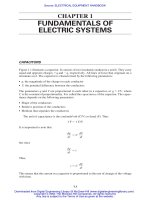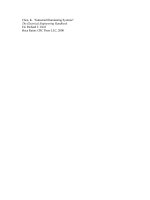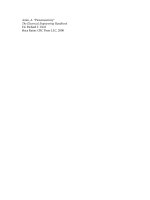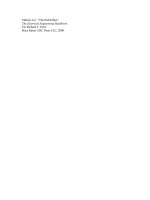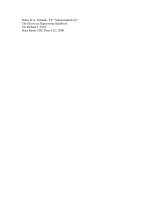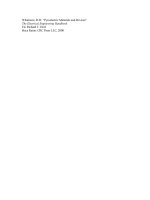ABB electrical installation handbook 6th edition2010
Bạn đang xem bản rút gọn của tài liệu. Xem và tải ngay bản đầy đủ của tài liệu tại đây (4.41 MB, 548 trang )
Technical guide - 6th edition 2010
Electrical installation handbook
Protection, control and electrical devices
Electrical installation handbook
Protection, control and electrical devices
First edition 2003
Second edition 2004
Third edition 2005
Fourth edition 2006
Fifth edition 2007
Sixth edition 2010
Published by ABB SACE
via Baioni, 35 - 24123 Bergamo (Italy)
All rights reserved
Electrical installation handbook
Protection, control and electrical devices
General aspects
Part 1
Protection and control devices
Part 2
Electrical devices
General aspects
Index
Introduction ............................................................................................................... 6
1 Standards
1.1 General aspects.............................................................................................. 7
1.2 IEC Standards for electrical installation........................................................... 19
Introduction
Scope and objectives
The scope of this electrical installation handbook is to provide the designer and
user of electrical plants with a quick reference, immediate-use working tool. This
is not intended to be a theoretical document, nor a technical catalogue, but, in
addition to the latter, aims to be of help in the correct definition of equipment,
in numerous practical installation situations.
The dimensioning of an electrical plant requires knowledge of different factors
relating to, for example, installation utilities, the electrical conductors and other
components; this knowledge leads the design engineer to consult numerous
documents and technical catalogues. This electrical installation handbook, however, aims to supply, in a single document, tables for the quick definition of the
main parameters of the components of an electrical plant and for the selection
of the protection devices for a wide range of installations. Some application
examples are included to aid comprehension of the selection tables.
Electrical installation handbook users
The electrical installation handbook is a tool which is suitable for all those who are
interested in electrical plants: useful for installers and maintenance technicians
through brief yet important electrotechnical references, and for sales engineers
through quick reference selection tables.
Validity of the electrical installation handbook
Some tables show approximate values due to the generalization of the selection process, for example those regarding the constructional characteristics of
electrical machinery. In every case, where possible, correction factors are given
for actual conditions which may differ from the assumed ones. The tables are
always drawn up conservatively, in favour of safety; for more accurate calculations, the use of DOCWin software is recommended for the dimensioning of
electrical installations.
6 Protection, control and electrical devices | ABB
1 Standards
1.1 General aspects
In each technical field, and in particular in the electrical sector, a condition
sufficient (even if not necessary) for the realization of plants according to the
“status of the art” and a requirement essential to properly meet the demands
of customers and of the community, is the respect of all the relevant laws and
technical standards.
Therefore, a precise knowledge of the standards is the fundamental premise
for a correct approach to the problems of the electrical plants which shall be
designed in order to guarantee that “acceptable safety level” which is never
absolute.
Juridical Standards
These are all the standards from which derive rules of behavior for the juridical
persons who are under the sovereignty of that State.
Technical Standards
These standards are the whole of the prescriptions on the basis of which
machines, apparatus, materials and the installations should be designed, manufactured and tested so that efficiency and function safety are ensured.
The technical standards, published by national and international bodies, are
circumstantially drawn up and can have legal force when this is attributed by
a legislative measure.
International Body
European Body
Application fields
Electrotechnics and
Telecommunications
Electronics
IEC
CENELEC
ITU
ETSI
Mechanics, Ergonomics
and Safety
ISO
CEN
This technical collection takes into consideration only the bodies dealing with electrical and electronic
technologies.
IEC International Electrotechnical Commission
The International Electrotechnical Commission (IEC) was officially founded in
1906, with the aim of securing the international co-operation as regards
standardization and certification in electrical and electronic technologies. This
association is formed by the International Committees of over 40 countries all
over the world.
The IEC publishes international standards, technical guides and reports which
are the bases or, in any case, a reference of utmost importance for any national
and European standardization activity.
IEC Standards are generally issued in two languages: English and French.
In 1991 the IEC has ratified co-operation agreements with CENELEC (European
standardization body), for a common planning of new standardization activities
and for parallel voting on standard drafts.
ABB | Protection, control and electrical devices 7
1.1 General aspects
1 Standards
CENELEC European Committee for Electrotechnical Standardization
The European Committee for Electrotechnical Standardization (CENELEC) was
set up in 1973. Presently it comprises 31 countries (Austria, Belgium, Bulgaria,
Cyprus, Croatia, Czech Republic, Denmark, Estonia, Finland, France, Germany,
Greece, Hungary, Iceland, Ireland, Italy, Latvia, Lithuania, Luxembourg, Malta,
Netherlands, Norway, Portugal, Poland, Romania, Slovakia, Slovenia, Spain,
Sweden, Switzerland, United Kingdom) and cooperates with 12 affiliates (Albania,
Belarus, Georgia, Bosnia and Herzegovina, Tunisia, Former Yugoslav Republic
of Macedonia, Serbia, Libia, Montenegro, Turkey, Ukraine and Israel) which have
first maintained the national documents side by side with the CENELEC ones
and then replaced them with the Harmonized Documents (HD).
There is a difference between EN Standards and Harmonization Documents
(HD): while the first ones have to be accepted at any level and without additions
or modifications in the different countries, the second ones can be amended
to meet particular national requirements.
EN Standards are generally issued in three languages: English, French and
German.
From 1991 CENELEC cooperates with the IEC to accelerate the standards
preparation process of International Standards.
CENELEC deals with specific subjects, for which standardization is urgently
required.
When the study of a specific subject has already been started by the IEC, the
European standardization body (CENELEC) can decide to accept or, whenever necessary, to amend the works already approved by the International
standardization body.
EC DIRECTIVES FOR ELECTRICAL EQUIPMENT
Among its institutional roles, the European Community has the task of promulgating directives which must be adopted by the different member states and
then transposed into national law.
Once adopted, these directives come into juridical force and become a reference for manufacturers, installers, and dealers who must fulfill the duties
prescribed by law.
Directives are based on the following principles:
•harmonization is limited to essential requirements;
•only the products which comply with the essential requirements specified by
the directives can be marketed and put into service;
•the harmonized standards, whose reference numbers are published in the
Official Journal of the European Communities and which are transposed
into the national standards, are considered in compliance with the essential
requirements;
•the applicability of the harmonized standards or of other technical specifications
is facultative and manufacturers are free to choose other technical solutions
which ensure compliance with the essential requirements;
•a manufacturer can choose among the different conformity evaluation procedure provided by the applicable directive.
The scope of each directive is to make manufacturers take all the necessary
steps and measures so that the product does not affect the safety and health
of persons, animals and property.
8 Protection, control and electrical devices | ABB
1.1 General aspects
1 Standards
“Low Voltage” Directive 2006/95/CE
The Low Voltage Directive refers to any electrical equipment designed for use
at a rated voltage from 50 to 1000 V for alternating current and from 75 to
1500 V for direct current.
In particular, it is applicable to any apparatus used for production, conversion,
transmission, distribution and use of electrical power, such as machines,
transformers, devices, measuring instruments, protection devices and wiring
materials.
The following categories are outside the scope of this Directive:
•electrical equipment for use in an explosive atmosphere;
•electrical equipment for radiology and medical purposes;
•electrical parts for goods and passenger lifts;
•electrical energy meters;
•plugs and socket outlets for domestic use;
•electric fence controllers;
•radio-electrical interference;
•specialized electrical equipment, for use on ships, aircraft or railways, which
complies with the safety provisions drawn up by international bodies in which
the Member States participate.
Directive EMC 2004/108/CE (“Electromagnetic Compatibility”)
The Directive on electromagnetic compatibility regards all the electrical and electronic apparatus as well as systems and installations containing electrical and/
or electronic components. In particular, the apparatus covered by this Directive
are divided into the following categories according to their characteristics:
•domestic radio and TV receivers;
•industrial manufacturing equipment;
•mobile radio equipment;
•mobile radio and commercial radio telephone equipment;
•medical and scientific apparatus;
•information technology equipment (ITE);
•domestic appliances and household electronic equipment;
•aeronautical and marine radio apparatus;
•educational electronic equipment;
•telecommunications networks and apparatus;
•radio and television broadcast transmitters;
•lights and fluorescent lamps.
The apparatus shall be so constructed that:
a) the electromagnetic disturbance it generates does not exceed a level allowing
radio and telecommunications equipment and other apparatus to operate
as intended;
b) the apparatus has an adequate level of intrinsic immunity to electromagnetic
disturbance to enable it to operate as intended.
An apparatus is declared in conformity to the provisions at points a) and b) when
the apparatus complies with the harmonized standards relevant to its product
family or, in case there aren’t any, with the general standards.
ABB | Protection, control and electrical devices 9
1.1 General aspects
1 Standards
CE conformity marking
The CE conformity marking shall indicate conformity to all the obligations imposed on the manufacturer, as regards his products, by virtue of the European
Community directives providing for the affixing of the CE marking.
When the CE marking is affixed on a product, it represents a declaration of the
manufacturer or of his authorized representative that the product in question
conforms to all the applicable provisions including the conformity assessment
procedures. This prevents the Member States from limiting the marketing and
putting into service of products bearing the CE marking, unless this measure
is justified by the proved non-conformity of the product.
Manufacturer
Technical file
EC declaration of
conformity
The manufacturer
draw up the technical
documentation
covering the design,
manufacture and
operation of the
product
The manufacturer
guarantees and declares
that his products are in
conformity to the technical
documentation and to the
directive requirements
Naval type approval
The environmental conditions which characterize the use of circuit breakers for
on-board installations can be different from the service conditions in standard
industrial environments; as a matter of fact, marine applications can require
installation under particular conditions, such as:
- environments characterized by high temperature and humidity, including saltmist atmosphere (damp-heat, salt-mist environment);
- on board environments (engine room) where the apparatus operate in the
presence of vibrations characterized by considerable amplitude and duration.
In order to ensure the proper function in such environments, the shipping registers require that the apparatus has to be tested according to specific type
approval tests, the most significant of which are vibration, dynamic inclination,
humidity and dry-heat tests.
10 Protection, control and electrical devices | ABB
ASDC008045F0201
Flow diagram for the conformity assessment procedures established by the Directive
2006/95/CE on electrical equipment designed for use within particular voltage range:
1.1 General aspects
1 Standards
ABB SACE circuit-breakers (Tmax-Emax) are approved by the following shipping registers:
•
•
•
•
•
•
RINA
DNV
BV
GL
LRs
ABS
Registro Italiano Navale
Det Norske Veritas
Bureau Veritas
Germanischer Lloyd
Lloyd’s Register of Shipping
American Bureau of Shipping
Italian shipping register
Norwegian shipping register
French shipping register
German shipping register
British shipping register
American shipping register
It is always advisable to ask ABB SACE as regards the typologies and the performances of the certified circuit-breakers or to consult the section certificates
in the website .
Marks of conformity to the relevant national and
international Standards
The international and national marks of conformity are reported in the following
table, for information only:
COUNTRY
Symbol
Mark designation
Applicability/Organization
EUROPE
–
Mark of compliance with the
harmonized European standards
listed in the ENEC Agreement.
AUSTRALIA
AS Mark
Electrical and non-electrical
products.
It guarantees compliance with
SAA (Standard Association of
Australia).
AUSTRALIA
S.A.A. Mark
Standards Association of Australia
(S.A.A.).
The Electricity Authority of New
South Wales Sydney Australia
AUSTRIA
Austrian Test Mark
Installation equipment and
materials
OVE
ABB | Protection, control and electrical devices 11
1.1 General aspects
1 Standards
COUNTRY
Symbol
Mark designation
Applicability/Organization
AUSTRIA
ÖVE Identification
Thread
Cables
BELGIUM
CEBEC Mark
Installation materials and electrical
appliances
BELGIUM
CEBEC Mark
Conduits and ducts, conductors
and flexible cords
BELGIUM
Certification of
Conformity
Installation material and electrical
appliances (in case there are no
equivalent national standards or
criteria)
CANADA
CSA Mark
Electrical and non-electrical
products.
This mark guarantees compliance
with CSA (Canadian Standard
Association)
CHINA
CCC Mark
This mark is required for a wide
range of manufactured products
before being exported to or sold
in the Peoples Republic of China
market.
Czech Republic
EZU’ Mark
Electrotechnical Testing Institute
Slovakia
Republic
EVPU’ Mark
Electrotechnical Research and
Design Institute
12 Protection, control and electrical devices | ABB
1.1 General aspects
1 Standards
COUNTRY
Symbol
Mark designation
Applicability/Organization
CROATIA
KONKAR
Electrical Engineering Institute
DENMARK
DEMKO
Approval Mark
Low voltage materials.
This mark guarantees the
compliance of the product with
the requirements (safety) of the
“Heavy Current Regulations”
FINLAND
Safety Mark
of the Elektriska
Inspektoratet
Low voltage material.
This mark guarantees the
compliance of the product with
the requirements (safety) of the
“Heavy Current Regulations”
FRANCE
ESC Mark
Household appliances
FRANCE
NF Mark
Conductors and cables – Conduits and ducting – Installation
materials
FRANCE
NF Identification
Thread
Cables
FRANCE
NF Mark
Portable motor-operated tools
FRANCE
NF Mark
Household appliances
ABB | Protection, control and electrical devices 13
1.1 General aspects
1 Standards
COUNTRY
Symbol
Mark designation
Applicability/Organization
GERMANY
VDE Mark
For appliances and technical
equipment, installation accessories such as plugs, sockets, fuses,
wires and cables, as well as other
components (capacitors, earthing
systems, lamp holders and electronic devices)
GERMANY
VDE
Identification Thread
Cables and cords
GERMANY
VDE Cable Mark
For cables, insulated cords, installation conduits and ducts
GERMANY
VDE-GS Mark
for technical
equipment
Safety mark for technical
equipment to be affixed after the
product has been tested and certified by the VDE Test Laboratory
in Offenbach; the conformity mark
is the mark VDE, which is granted
both to be used alone as well as
in combination with the mark GS
HUNGARY
MEEI
Hungarian Institute for Testing
and Certification of Electrical
Equipment
JAPAN
JIS Mark
Mark which guarantees compliance with the relevant Japanese
Industrial Standard(s).
IRELAND
IIRS Mark
Electrical equipment
IIRS Mark
Electrical equipment
geprüfte
Sicherheit
IRELAND
OF
CO N F
O
TY
MAR
MI
K
R
I . I. R . S .
14 Protection, control and electrical devices | ABB
1.1 General aspects
1 Standards
COUNTRY
Symbol
Mark designation
Applicability/Organization
ITALY
IMQ Mark
Mark to be affixed on electrical
material for non-skilled users;
it certifies compliance with the
European Standard(s).
NORWAY
Norwegian Approval
Mark
Mandatory safety approval for low
voltage material and equipment
NETHERLANDS
KEMA-KEUR
General for all equipment
KWE
Electrical products
Certification of Conformity
Electrical and non-electrical products. It guarantees compliance
with national standard (Gosstandard of Russia)
SISIR
Electrical and non-electrical
products
SIQ
Slovenian Institute of Quality and
Metrology
AEE
Electrical products.
The mark is under the control of
the Asociación Electrotécnica
Española (Spanish Electrotechnical Association)
KEUR
POLAND
B
RUSSIA
GAPO
R
STA N D AR
PP
SIN
D
O
E
R O V ED T
SINGAPORE
A
SLOVENIA
FO
R M I DA D A
R MA S U N
E
AR
NO
C A DE CON
SPAIN
ABB | Protection, control and electrical devices 15
M
1.1 General aspects
1 Standards
COUNTRY
Symbol
Mark designation
Applicability/Organization
Asociación Española de Normalización y Certificación.
(Spanish Standarization and
Certification Association)
SWEDEN
SEMKO
Mark
Mandatory safety approval for low
voltage material and equipment.
SWITZERLAND
Safety Mark
Swiss low voltage material subject
to mandatory approval (safety).
SWITZERLAND
–
Cables subject to mandatory
approval
SWITZERLAND
SEV Safety Mark
Low voltage material subject to
mandatory approval
UNITED
KINGDOM
ASTA Mark
Mark which guarantees compliance with the relevant “British
Standards”
UNITED
KINGDOM
BASEC Mark
Mark which guarantees compliance with the “British Standards” for
conductors, cables and ancillary
products.
UNITED
KINGDOM
BASEC
Identification Thread
Cables
K
C
FI
ER
TI
AR
M
C
E
AD
AT
I
O
N
AENOR
TR
SPAIN
16 Protection, control and electrical devices | ABB
1.1 General aspects
1 Standards
COUNTRY
Symbol
Mark designation
Applicability/Organization
UNITED
KINGDOM
BEAB
Safety Mark
Compliance with the “British Standards” for household appliances
UNITED
KINGDOM
BSI
Safety Mark
Compliance with the “British
Standards”
BEAB
Kitemark
Compliance with the relevant
“British Standards” regarding
safety and performances
UNDERWRITERS
LABORATORIES
Mark
Electrical and non-electrical
products
U.S.A.
UNDERWRITERS
LABORATORIES
Mark
Electrical and non-electrical
products
U.S.A.
UL Recognition
Electrical and non-electrical
products
CEN
CEN Mark
Mark issued by the European
Committee for Standardization
(CEN): it guarantees compliance
with the European Standards.
CENELEC
Mark
Cables
H
ND
DENT LA B
OR
EN
Y
AN I
PP
D
EP
OR
AT
A
U.S.A.
B R IT I S
ROVED
TO
A N D AR
ST
UNITED
KINGDOM
N
FO
AF
TI
ET
Y
TES
G
R P U B L IC
S
L I S T E D
(Product Name)
(Control Number)
ABB | Protection, control and electrical devices 17
1.1 General aspects
1 Standards
COUNTRY
Symbol
Mark designation
Applicability/Organization
CENELEC
Harmonization Mark
Certification mark providing
assurance that the harmonized
cable complies with the relevant
harmonized CENELEC Standards
– identification thread
EC
Ex EUROPEA Mark
Mark assuring the compliance
with the relevant European Standards of the products to be used
in environments with explosion
hazards
CEEel
CEEel Mark
Mark which is applicable to some
household appliances (shavers,
electric clocks, etc).
EC - Declaration of Conformity
The EC Declaration of Conformity is the statement of the manufacturer, who
declares under his own responsibility that all the equipment, procedures or
services refer and comply with specific standards (directives) or other normative
documents.
The EC Declaration of Conformity should contain the following information:
•name and address of the manufacturer or by its European representative;
•description of the product;
•reference to the harmonized standards and directives involved;
•any reference to the technical specifications of conformity;
•the two last digits of the year of affixing of the CE marking;
•identification of the signer.
A copy of the EC Declaration of Conformity shall be kept by the manufacturer
or by his representative together with the technical documentation.
18 Protection, control and electrical devices | ABB
1 Standards
1.2 IEC Standards for electrical
installation
The following pages list the main Standards which refer to the most common
low voltage electrical applications and report their publication years.
The Standards might have been amended, but the relevant amendaments are
not mentioned here.
STANDARD
IEC 60027-1
YEAR
1992
TITLE
Letter symbols to be used in ectrical
technology - Part 1: General
IEC 60034-1
2010
Rotating electrical machines - Part 1: Rating
and performance
IEC 60617-DB-Snapshot 2010
Graphical symbols for diagrams
IEC 61082-1
2006
Preparation of documents used in
electrotechnology - Part 1: Rules
IEC 60038
2009
IEC standard voltages
IEC 60664-1
2007
Insulation coordination for equipment within
low-voltage systems - Part 1: Principles, requirements and tests
IEC 60909-0
2001
Short-circuit currents in three-phase a.c. systems - Part 0: Calculation of currents
IEC 60865-1
1993
Short-circuit currents - Calculation of effects Part 1: Definitions and calculation methods
IEC 60076-1
2000
Power transformers - Part 1: General
IEC 60076-2
1993
Power transformers - Part 2: Temperature rise
IEC 60076-3
2000
Power transformers - Part 3: Insulation levels,
dielectric tests and external clearances in air
IEC 60076-5
2006
Power transformers - Part 5: Ability to withstand short circuit
IEC/TR 60616
1978
Terminal and tapping markings for power
transformers
IEC 60076-11
2004
Power transformers - Part 11: Dry-type transformers
IEC 60445
2010
Basic and safety principles for man-machine
interface, marking and identification - Identification of equipment terminals and conductor
terminations
IEC 60073
2002
Basic and safety principles for man-machine
interface, marking and identification – Coding
for indicators and actuators
IEC 60447
2004
Basic and safety principles for man-machine
interface, marking and identification - Actuating
principles
IEC 60947-1
2007
Low-voltage switchgear and controlgear - Part
1: General rules
IEC 60947-2
2009
Low-voltage switchgear and controlgear - Part
2: Circuit-breakers
ABB | Protection, control and electrical devices 19
1.2 IEC standards for electrical installation
1 Standards
STANDARD
IEC 60947-3
YEAR
2008
TITLE
Low-voltage switchgear and controlgear - Part
3: Switches, disconnectors, switch-disconnectors and fuse-combination units
IEC 60947-4-1
2009
Low-voltage switchgear and controlgear - Part
4-1: Contactors and motor-starters – Electromechanical contactors and motor-starters
IEC 60947-4-2
2007
Low-voltage switchgear and controlgear - Part
4-2: Contactors and motor-starters – AC semiconductor motor controllers and starters
IEC 60947-4-3
2007
Low-voltage switchgear and controlgear Part 4-3: Contactors and motor-starters – AC
semiconductor controllers and contactors for
non-motor loads
IEC 60947-5-1
2009
Low-voltage switchgear and controlgear - Part
5-1: Control circuit devices and switching
elements - Electromechanical control circuit
devices
IEC 60947-5-2
2007
Low-voltage switchgear and controlgear - Part
5-2: Control circuit devices and switching
elements – Proximity switches
IEC 60947-5-3
2005
Low-voltage switchgear and controlgear - Part
5-3: Control circuit devices and switching
elements – Requirements for proximity devices
with defined behaviour under fault conditions
IEC 60947-5-4
2002
Low-voltage switchgear and controlgear Part 5: Control circuit devices and switching
elements – Section 4: Method of assessing the
performance of low energy contacts. Special
tests
IEC 60947-5-5
2005
Low-voltage switchgear and controlgear - Part
5-5: Control circuit devices and switching
elements - Electrical emergency stop device
with mechanical latching function
IEC 60947-5-6
1999
Low-voltage switchgear and controlgear - Part
5-6: Control circuit devices and switching
elements – DC interface for proximity sensors
and switching amplifiers (NAMUR)
IEC 60947-6-1
2005
Low-voltage switchgear and controlgear - Part
6-1: Multiple function equipment – Transfer
switching equipment
IEC 60947-6-2
2007
Low-voltage switchgear and controlgear - Part
6-2: Multiple function equipment - Control and
protective switching devices (or equipment)
(CPS)
IEC 60947-7-1
2009
Low-voltage switchgear and controlgear - Part
7: Ancillary equipment - Section 1: Terminal
blocks for copper conductors
20 Protection, control and electrical devices | ABB
1.2 IEC standards for electrical installation
1 Standards
STANDARD
IEC 60947-7-2
YEAR
2009
TITLE
Low-voltage switchgear and controlgear - Part
7: Ancillary equipment - Section 2: Protective conductor terminal blocks for copper
conductors
IEC 61439-1
2009
Low-voltage switchgear and controlgear
assemblies - Part 1: General rules
IEC 60439-2
2005
Low-voltage switchgear and controlgear
assemblies - Part 2: Particular requirements for
busbar trunking systems (busways)
IEC 60439-3
2001
Low-voltage switchgear and controlgear
assemblies - Part 3: Particular requirements
for low-voltage switchgear and controlgear
assemblies intended to be installed in places
where unskilled persons have access for their
use - Distribution boards
IEC 60439-4
2004
Low-voltage switchgear and controlgear
assemblies - Part 4: Particular requirements for
assemblies for construction sites (ACS)
IEC 60439-5
2006
Low-voltage switchgear and controlgear
assemblies - Part 5: Particular requirements
for assemblies for power distribution in public
networks
IEC 61095
2009
Electromechanical contactors for household
and similar purposes
IEC/TR 60890
1987
A method of temperature-rise assessment
by extrapolation for partially type-tested
assemblies (PTTA) of low-voltage switchgear
and controlgear
IEC/TR 61117
1992
A method for assessing the short-circuit
withstand strength of partially type-tested
assemblies (PTTA)
IEC 60092-303
1980
Electrical installations in ships. Part 303:
Equipment - Transformers for power and
lighting
IEC 60092-301
1980
Electrical installations in ships. Part 301:
Equipment - Generators and motors
IEC 60092-101
2002
Electrical installations in ships - Part 101:
Definitions and general requirements
IEC 60092-401
1980
Electrical installations in ships. Part 401:
Installation and test of completed installation
IEC 60092-201
1994
Electrical installations in ships - Part 201:
System design - General
IEC 60092-202
1994
Electrical installations in ships - Part 202:
System design - Protection
ABB | Protection, control and electrical devices 21
1.2 IEC standards for electrical installation
1 Standards
STANDARD
IEC 60092-302
YEAR
1997
TITLE
Electrical installations in ships - Part 302: Lowvoltage switchgear and controlgear assemblies
IEC 60092-350
2008
Electrical installations in ships - Part 350:
General construction and test methods of
power, control and instrumentation cables for
shipboard and offshore applications
IEC 60092-352
2005
Electrical installations in ships - Part 352:
Choice and installation of electrical cables
IEC 60364-5-52
2009
Electrical installations of buildings - Part 5-52:
Selection and erection of electrical equipment
– Wiring systems
IEC 60227
IEC 60228
Polyvinyl chloride insulated cables of rated
voltages up to and including 450/750 V
2007
Part 1: General requirements
2003
Part 2: Test methods
1997
Part 3: Non-sheathed cables for fixed wiring
1997
Part 4: Sheathed cables for fixed wiring
2003
Part 5: Flexible cables (cords)
2001
Part 6: Lift cables and cables for flexible
connections
2003
Part 7: Flexible cables screened and
unscreened with two or more conductors
2004
Conductors of insulated cables
IEC 60245
Rubber insulated cables - Rated voltages up to
and including 450/750 V
2008
Part 1: General requirements
1998
Part 2: Test methods
1994
Part 3: Heat resistant silicone insulated cables
2004
Part 4: Cord and flexible cables
1994
Part 5: Lift cables
1994
Part 6: Arc welding electrode cables
1994
Part 7: Heat resistant ethylene-vinyl acetate
rubber insulated cables
2004
Part 8: Cords for applications requiring high
flexibility
IEC 60309-2
2005
Plugs, socket-outlets and couplers for industrial purposes - Part 2: Dimensional interchangeability requirements for pin and contact-tube
accessories
IEC 61008-1
2010
Residual current operated circuit-breakers
without integral overcurrent protection for
household and similar uses (RCCBs) - Part 1:
General rules
IEC 61008-2-1
1990
Residual current operated circuit-breakers
without integral overcurrent protection for
household and similar uses (RCCB’s). Part 2-1:
Applicability of the general rules to RCCB’s
functionally independent of line voltage
22 Protection, control and electrical devices | ABB
1.2 IEC standards for electrical installation
1 Standards
STANDARD
IEC 61008-2-2
YEAR
1990
TITLE
Residual current operated circuit-breakers
without integral overcurrent protection for
household and similar uses (RCCB’s). Part 2-2:
Applicability of the general rules to RCCB’s
functionally dependent on line voltage
IEC 61009-1
2010
Residual current operated circuit-breakers with
integral overcurrent protection for household
and similar uses (RCBOs) - Part 1: General
rules
IEC 61009-2-1
1991
Residual current operated circuit-breakers with
integral overcurrent protection for household
and similar uses (RCBO’s) Part 2-1: Applicability of the general rules to RCBO’s functionally
independent of line voltage
IEC 61009-2-2
1991
Residual current operated circuit-breakers with
integral overcurrent protection for household
and similar uses (RCBO’s) - Part 2-2: Applicability of the general rules to RCBO’s functionally dependent on line voltage
IEC 60670-1
2002
Boxes and enclosures for electrical accessories for household and similar fixed electrical
installations - Part 1: General requirements
IEC 60669-2-1
2009
Switches for household and similar fixed
electrical installations - Part 2-1: Particular
requirements – Electronic switches
IEC 60669-2-2
2006
Switches for household and similar fixed
electrical installations - Part 2: Particular requirements - Section 2: Remote-control switches
(RCS)
IEC 60669-2-3
2006
Switches for household and similar fixed
electrical installations - Part 2-3: Particular
requirements – Time-delay switches (TDS)
IEC 60079-10-1
2009
Explosive atmospheres Part 10 -1: Cassification
of area - explosive gas atmospheres
IEC 60079-14
2007
Explosive atmospheres Part 14: Electrical
installation design, selection and erection
IEC 60079-17
2007
Electrical apparatus for explosive gas
atmospheres - Part 17: Inspection and
maintenance of electrical installations in
hazardous areas (other than mines)
IEC 60269-1
2009
Low-voltage fuses - Part 1: General
requirements
IEC 60269-2
2010
Low-voltage fuses. Part 2: Supplementary
requirements for fuses for use by authorized
persons (fuses mainly for industrial application)
examples of standardized system of fuses A to J
ABB | Protection, control and electrical devices 23



